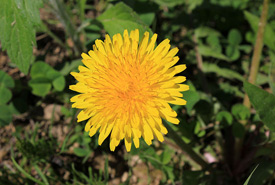Dissecting the dandelion

Dandelion (Photo by Yinan Chen, Wikimedia Commons)
This past summer I found myself in an unexpected scenario: on a wild foraging expedition in the heart of a concrete jungle, in my own backyard. The middle of a backyard, from house to gravel alleyway, is not the first place that comes to mind when considering food sources, but that is the wonder and potential of urban backyards.
I stood on a concrete slab and marveled at an entire miniature forest of common weeds grown wild within arms’-reach, and felt a shift in perception. These “weeds” are in fact bounties of nutrition, not only edible but also medicinal. While munching on dandelion leaves picked from right outside my door I realized that these plants have complexities far beyond the designation of “weeds,” and stewardship of the natural environment can begin the moment you step outside your door into your urban landscape.
The term “weed” has no botanical significance, but simply refers to a plant that grows in a place where it is not wanted, often invasively. The weeds in our backyard exist because they are particularly successful at coexisting with humans.
When it comes to dandelions, the globally recognized cheerful yellow flower, they have the ability to withstand trampling, leaves that can escape lawn mowers and prolific seed dispersal abilities, allowing them to thrive in the urban environment. The dandelion grows so well in our urban spaces that any endeavours to eradicate it from your backyard can seem futile.
A much easier solution would be a shift in our attitude toward the dandelion; a breakdown of the underlying assumption that it is a “weed” that has no value. It is time to embrace undesirable species in our backyards, choose to pick instead of poison and learn to use them to our advantage.
Among the merits of the dandelion are its nutritional qualities:

Comparison of nutritional density between dandelion greens and spinach (Illustration by Chloe Saunders)
Beyond being a weed, dandelions represent a gateway to understanding and connection with the natural world. In Rebecca McLain’s article, titled “Gathering ‘Wild’ Food in the City” from the International Journal of Justice and Sustainability, research into the impact of foraging wild edibles suggests that people are more in tune with their environment when it directly nourishes their body, and in turn, soul.
The act of eating our backyard weeds can challenge us to question boundaries, roles and relationships of humans in green spaces, no matter how small or urban. The thoughtful reconnection of an urbanite to a natural ecosystem can help to broaden their perception of the natural world and their desire to conserve it.
Dandelion parts and their usage

(Illustration by Chloe Saunders)

(Illustration by Chloe Saunders)


